Research on Improving Concrete Durability by Biomineralization Technology
Abstract
1. Introduction
2. Experimental Details
2.1. Test Program
2.2. Materials
2.3. Strain Implantation
- (1)
- Immerse the treated lightweight aggregates in a nutrient source containing 80 g/L of calcium lactate and 1 g/L of yeast extract for 30 min.
- (2)
- After soaking, drain the moisture from the lightweight aggregates and place them in an oven at 37 °C for 5 days.
- (3)
- Repeat steps (1) and (2) once, and then immerse the lightweight aggregates into the nutrient source twice.
- (4)
- Dip the lightweight aggregates containing the nutrition source into the bacterial spore solution for 30 min.
- (5)
- Drain the soaked lightweight aggregates and place them in an oven at 37 °C for 5 days to complete the implantation of the strains in the lightweight aggregates.
2.4. Mix Proportions
2.5. Curing Methods
2.6. Test Methods
3. Results and Discussion
3.1. Sporosarcina pasteurii Strain Sporulation and Reactivation Confirmation Test
3.2. Test Results of Compressive Strength of Biomineralized Concrete
3.3. Results of Water Permeability and Residual Strength Tests after Biomineralization Repair
3.4. Test Results of Chloride Ion Penetration of Biomineralized Concrete
4. Conclusions
- Biomineralized lightweight aggregate concrete can significantly increase its early strength due to biomineralization, and its 7 day strength was increased by about 33% compared with the control group. In the later period, as the hydration reaction of the concrete tended to be complete, the matrix became denser, resulting in insufficient oxygen in the concrete. As a result, it was not easy for Sporosarcina pasteurii to operate, which slowed down the growth of the concrete strength.
- The results of water permeability tests show that the permeation depth and total permeation area of lightweight aggregate concrete containing biological bacteria were smaller than those of the control group. This confirms that biomineralization can strengthen the ITZ in concrete and repair concrete cracks, thereby increasing the compactness of concrete and improving its durability.
- The chloride ion test results show that the electric flux of lightweight aggregate concrete containing biological bacteria was lower than that of the control group, indicating that biomineralization can strengthen the ITZ in concrete and repair concrete cracks, thereby improving the durability of concrete.
- The reduction ratio of the residual compressive strength of the biomineralized concrete was lower than that of the control group concrete, indicating that biomineralization can repair the damaged concrete and help it to maintain a certain residual strength. In particular, the residual strength of the experimental group using cyclic curing was even higher than the original strength of the control group. This result shows that biomineralization does have the effect of repairing concrete cracks.
- This study demonstrates that the use of lightweight aggregate as a carrier and the implantation of Sporosarcina pasteurii can induce biomineralization, strengthen the ITZ, and repair small internal cracks in concrete, thereby improving the strength and durability of the concrete.
Author Contributions
Funding
Acknowledgments
Conflicts of Interest
References
- Mindess, S.; Young, J.F.; Darwin, D. Concrete, 2nd ed.; Prentice-Hall: Upper Saddle River, NJ, USA, 2003. [Google Scholar]
- Metha, P.K.; Monteiro, P.J.M. Concrete: Microstructure, Properties and Materials, 3rd ed.; McGraw-Hill: New York, NY, USA, 2006. [Google Scholar]
- Sierra-Beltran, M.G.; Jonkers, H.M.; Schlangen, E. Characterization of sustainable bio-based mortar for concrete repair. Constr. Build. Mater. 2014, 67, 344–352. [Google Scholar] [CrossRef]
- Dry, C.M. Three designs for the internal release of sealants, adhesives, and waterproofing chemicals into concrete to reduce permeability. Cem. Concr. Res. 2000, 30, 1969–1977. [Google Scholar] [CrossRef]
- Castro-Alonso, M.J.; Montañez-Hernandez, L.E.; Sanchez-Muñoz, M.A.; Franco, M.R.M.; Narayanasamy, R.; Balagurusamy, N. Microbially Induced Calcium Carbonate Precipitation (MICP) and Its Potential in Bioconcrete: Microbiological and Molecular Concepts. Front. Mater. 2019, 6, 126. [Google Scholar] [CrossRef]
- Menon, R.R.; Luo, J.; Chen, X.; Zhou, H.; Liu, Z.; Zhou, G.; Zhang, N.; Jin, C. Screening of fungi for potential application of self-healing concrete. Sci. Rep. 2019, 9, 2075. [Google Scholar] [CrossRef] [PubMed]
- Han, S.; Choi, E.K.; Park, W.; Yi, C.; Chung, N. Effectiveness of expanded clay as a bacteria carrier for self-healing concrete. Appl. Biol. Chem. 2019, 62, 19. [Google Scholar] [CrossRef]
- Magaji, A.; Yakubu, M.; Wakawa, Y.M. A review paper on self healing concrete. Int. J. Eng. Sci. 2019, 8, 47–54. [Google Scholar]
- Sikder, A.; Saha, P. Effect of Bacteria on Performance of Concrete/Mortar: A Review. Int. J. Recent Technol. Eng. 2019, 7, 23. [Google Scholar]
- Xu, J.; Wang, X. Self-healing of concrete cracks by use of bacteria-containing low alkali cementitious material. Constr. Build. Mater. 2018, 167, 1–14. [Google Scholar] [CrossRef]
- Xu, J.; Wang, X.; Zuo, J.; Liu, X. Self-healing of concrete cracks by ceramsite-loaded microorganisms. Adv. Mater. Sci. Eng. 2018, 2018, 1–8. [Google Scholar] [CrossRef]
- Tsangouri, E. A decade of research on self-healing concrete. Sustain. Constr. Build. Mater. 2018. [Google Scholar] [CrossRef]
- Iheanyichukwu, C.G.; Umar, S.A.; Ekwueme, P.C. A Review on Self-Healing Concrete Using Bacteria. Sustain. Struct. Mater. Int. J. 2018, 1, 12–20. [Google Scholar]
- Kadapure, S.A.; Kulkarni, G.S.; Prakash, K.B. Biomineralization technique in self-healing of fly-ash concrete. Sustain. Build. Technol. Urban Dev. 2017, 8, 54–65. [Google Scholar] [CrossRef]
- Palin, D.; Wiktor, V.; Jonkers, H.M. A bacteria-based self-healing cementitious composite for application in low-temperature marine environments. Biomimetics 2017, 2, 13. [Google Scholar] [CrossRef] [PubMed]
- Souradeep, G.; Dai, P.S.; Wei, K.H. Autonomous healing in concrete by bio-based healing agents—A review. Constr. Build. Mater. 2017, 146, 419–428. [Google Scholar]
- Feiteira, J.; Tsangouri, E.; Gruyaert, E.; Lors, C.; Louis, G.; De Belie, N. Monitoring crack movement in polymer-based self-healing concrete through digital image correlation, acoustic emission analysis and SEM in-situ loading. Mater. Des. 2017, 115, 238–246. [Google Scholar] [CrossRef]
- Lee, J.C.; Lee, C.J.; Chun, W.Y.; Kim, W.J.; Chung, C.W. Effect of Microorganism Sporosarcina pasteurii on the Hydration of Cement Paste. J. Microbiol. Biotechnol. 2015, 25, 1328–1338. [Google Scholar] [CrossRef]
- Gao, L.; Sun, G. Development of microbial technique in self-healing of concrete cracks. J. Chin. Ceram. Soc. 2013, 41, 627–636. [Google Scholar]
- Chen, P.Y.; McKittrick, J.; Meyers, M.A. Biological materials: Functional adaptations and bioinspired designs. Prog. Mater. Sci. 2012, 57, 1492–1704. [Google Scholar] [CrossRef]
- Edvardsen, C. Water permeability and autogenous healing of cracks in concrete. ACI Mater. J. 1999, 96, 448–454. [Google Scholar]
- Hearn, N. Self-sealing, autogenous healing and continued hydration: What is the difference? Mater. Struct. 1998, 31, 563–567. [Google Scholar] [CrossRef]
- Frankel, R.B.; Bazylinski, D.A. Biologically induced mineralization by bacteria. Rev. Mineral. Geochem. 2003, 54, 95–114. [Google Scholar] [CrossRef]
- Krampitz, G.; Graser, G. Molecular mechanism of biomineralization in the formation of calcified shells. Angew. Chem. Int. Ed. Engl. 1988, 27, 145–1156. [Google Scholar] [CrossRef]
- Minto, J.M.; Tan, Q.; Lunn, R.J.; Mountassir, G.E.; Guo, H.; Cheng, X. ‘Microbial mortar’-restoration of degraded marble structures with microbially induced carbonate precipitation. Constr. Build. Mater. 2018, 180, 44–54. [Google Scholar] [CrossRef]
- Bang, S.S.; Galinat, J.K.; Ramakrishnan, V. Calcite precipitation induced by polyurethane-immobilized Bacillus pasteurii. Enzym. Microb. Technol. 2001, 28, 404–409. [Google Scholar] [CrossRef]
- Bachmeier, K.L.; Williams, A.E.; Warmington, J.R.; Bang, S.S. Urease activity in microbiologically-induced calcite precipitation. J. Biotechnol. 2002, 93, 171–181. [Google Scholar] [CrossRef]
- De Muynck, W.; De Belie, N.; Verstraete, W. Microbial carbonate precipitation improves the durability of cementitious materials: A review. Ecol. Eng. 2010, 36, 118–136. [Google Scholar] [CrossRef]
- Ramachandran, S.K.; Ramakrishnan, V.; Bang, S.S. Remediation of concrete using micro-organisms. ACI Mater. J. 2001, 98, 3–9. [Google Scholar]
- Jonkers, H.M.; Thijssen, A.; Muyzer, G.; Copuroglu, O.; Schlangen, E. Application of bacteria as self-healing agent for the development of sustainable concrete. Ecol. Eng. 2010, 36, 230–235. [Google Scholar] [CrossRef]
- Wiktor, V.; Jonkers, H.M. Quantification of crack-healing in novel bacteria-based self-healing concrete. Cem. Concr. Compos. 2011, 33, 763–770. [Google Scholar] [CrossRef]
- Bravo da Silva, F.; De Belie, N.; Boon, N.; Verstraete, W. Production of non-axenic ureolytic spores for self-healing concrete applications. Constr. Build. Mater. 2015, 93, 1034–1041. [Google Scholar] [CrossRef]
- Ollivier, J.P.; Maso, J.C.; Bourdette, B. Interfacial transition zone in concrete. Adv. Cem. Based Mater. 1995, 2, 30–38. [Google Scholar] [CrossRef]
- CNS 1232:2002. Method of Test for Compressive Strength of Cylindrical Concrete Specimens; Chinese National Standards, Bureau of Standards, Metrology and Inspection of the Ministry of Economic Affairs: Taipei, Taiwan, 2002.
- CNS 14795:2004. Method of Test for Electrical Indication of Concrete’s Ability to Resist Chloride Ion Penetration; Chinese National Standards, Bureau of Standards, Metrology and Inspection of the Ministry of Economic Affairs: Taipei, Taiwan, 2004.
- Chen, H.J.; Peng, C.F.; Tang, C.W.; Chen, Y.T. Self-Healing Concrete by Biological Substrate. Materials 2019, 12, 4099. [Google Scholar] [CrossRef] [PubMed]
- Balam, N.H.; Mostofinejad, D.; Eftekhar, M. Effects of bacterial remediation on compressive strength, water absorption, and chloride permeability of lightweight aggregate concrete. Constr. Build. Mater. 2017, 145, 107–116. [Google Scholar] [CrossRef]
- Harikrishnan, H.; Kadaikunnan, S.; Moorthy, I.G.; Anuf, A.R.; Ponmurugan, K.; Kumar, R.S. Improvement of concrete durability by bacterial carbonate precipitation. South Indian J. Biol. Sci. 2015, 1, 90–96. [Google Scholar] [CrossRef]
- Wu, M.; Hu, X.; Zhang, Q.; Xue, D.; Zhao, Y. Growth environment optimization for inducing bacterial mineralization and its application in concrete healing. Constr. Build. Mater. 2019, 209, 631–643. [Google Scholar] [CrossRef]
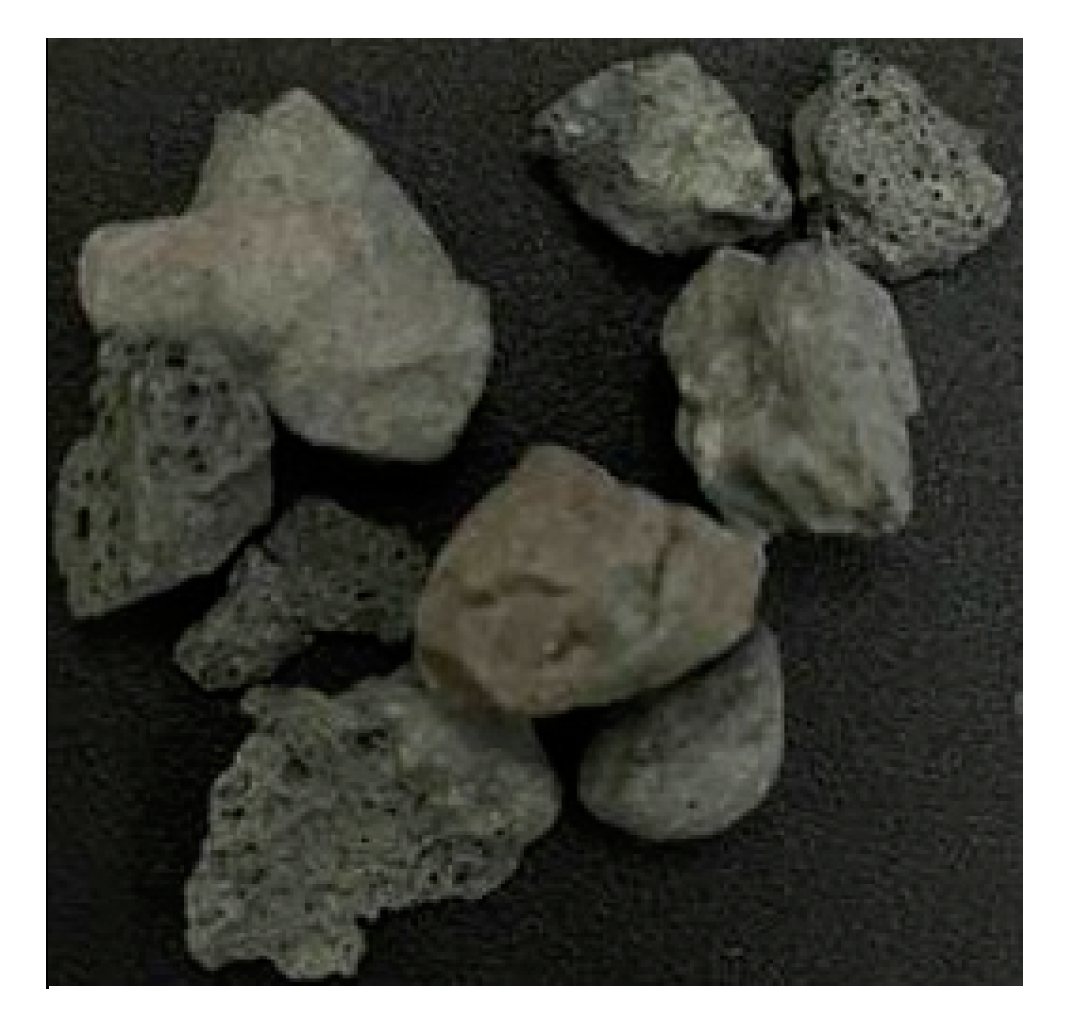
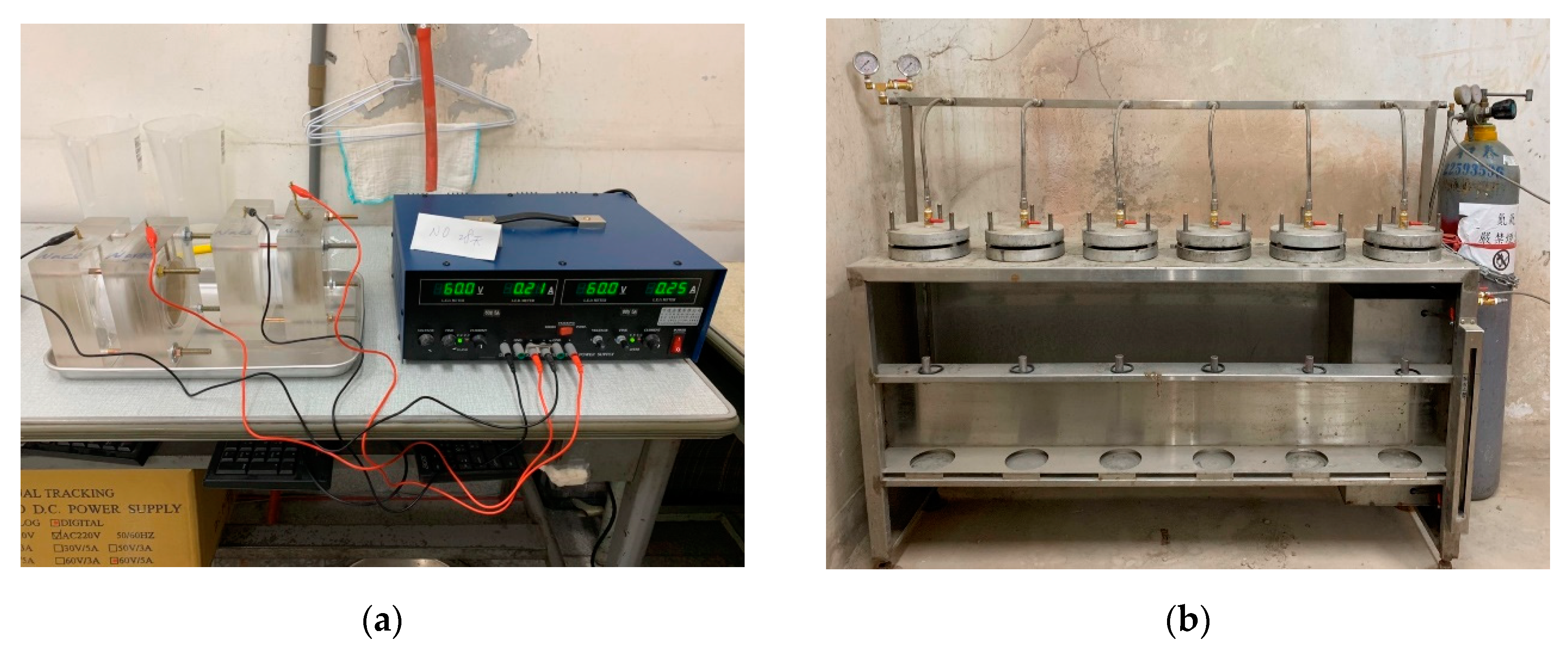
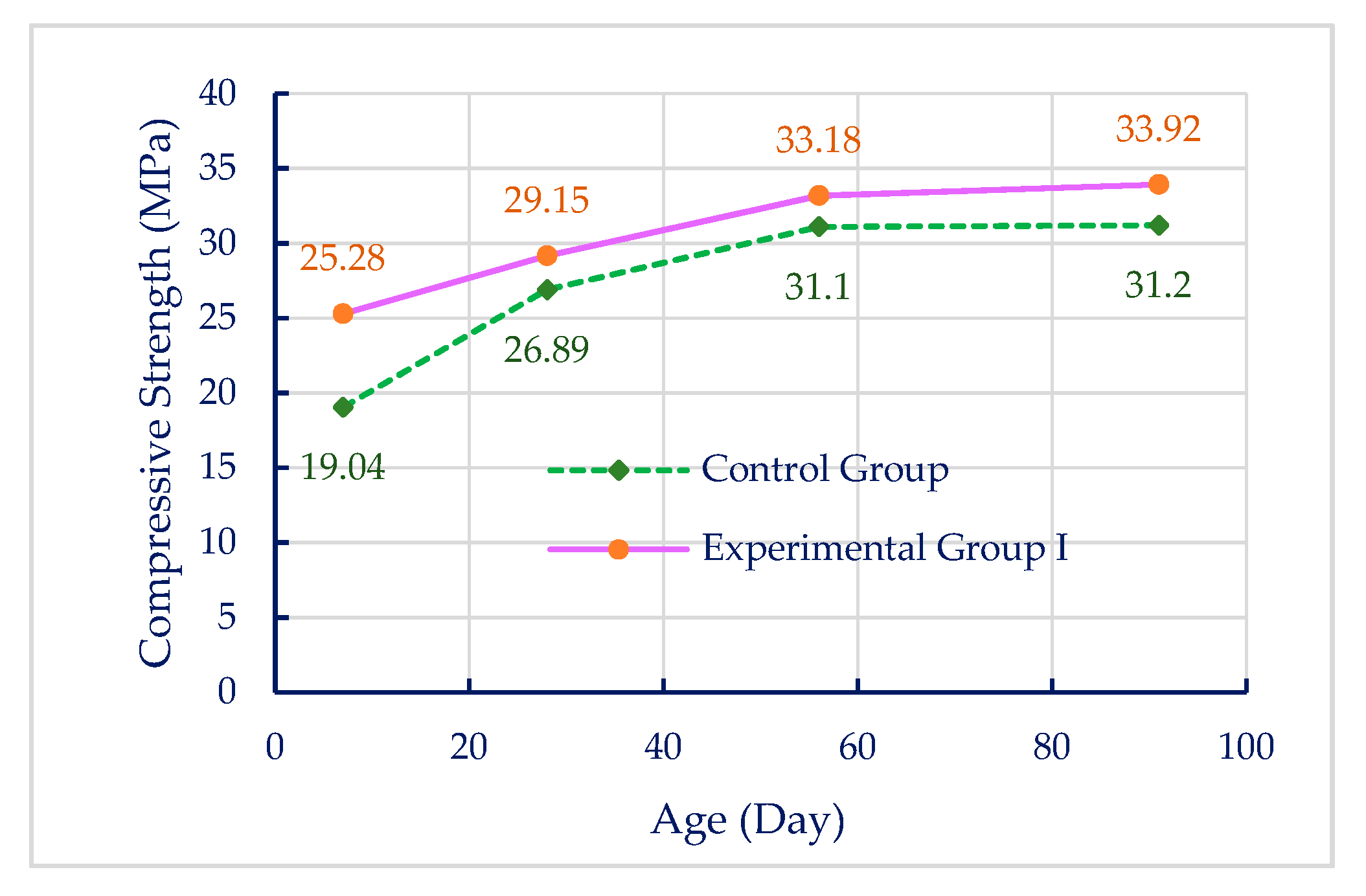
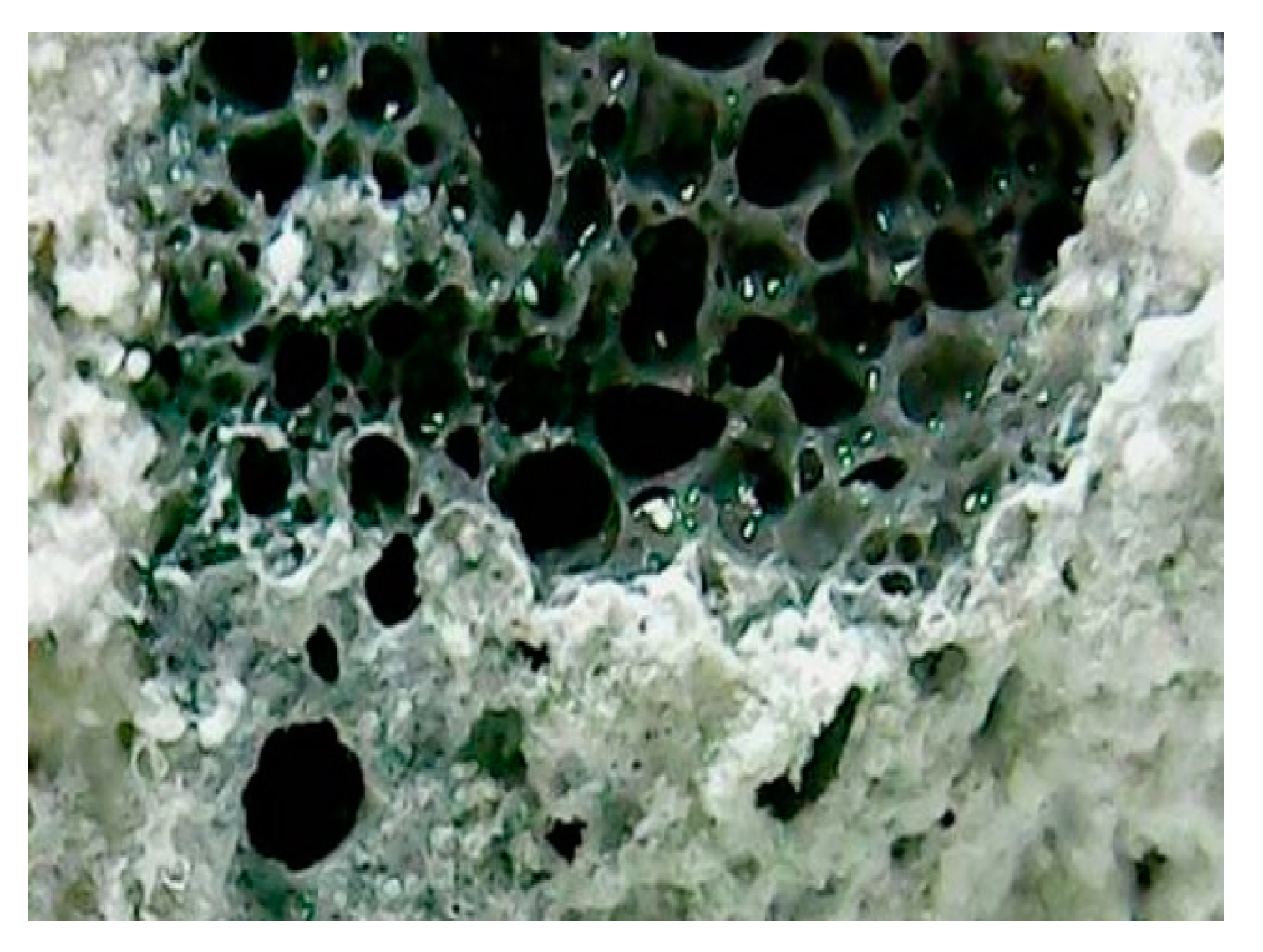
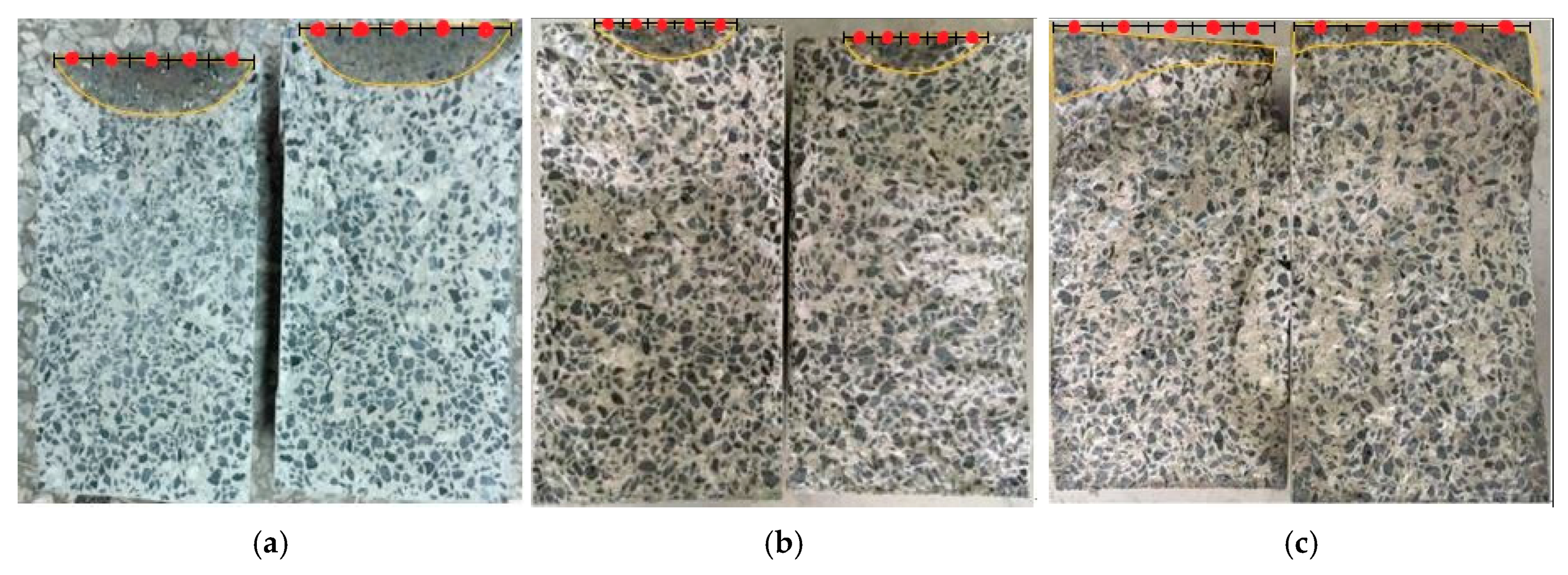
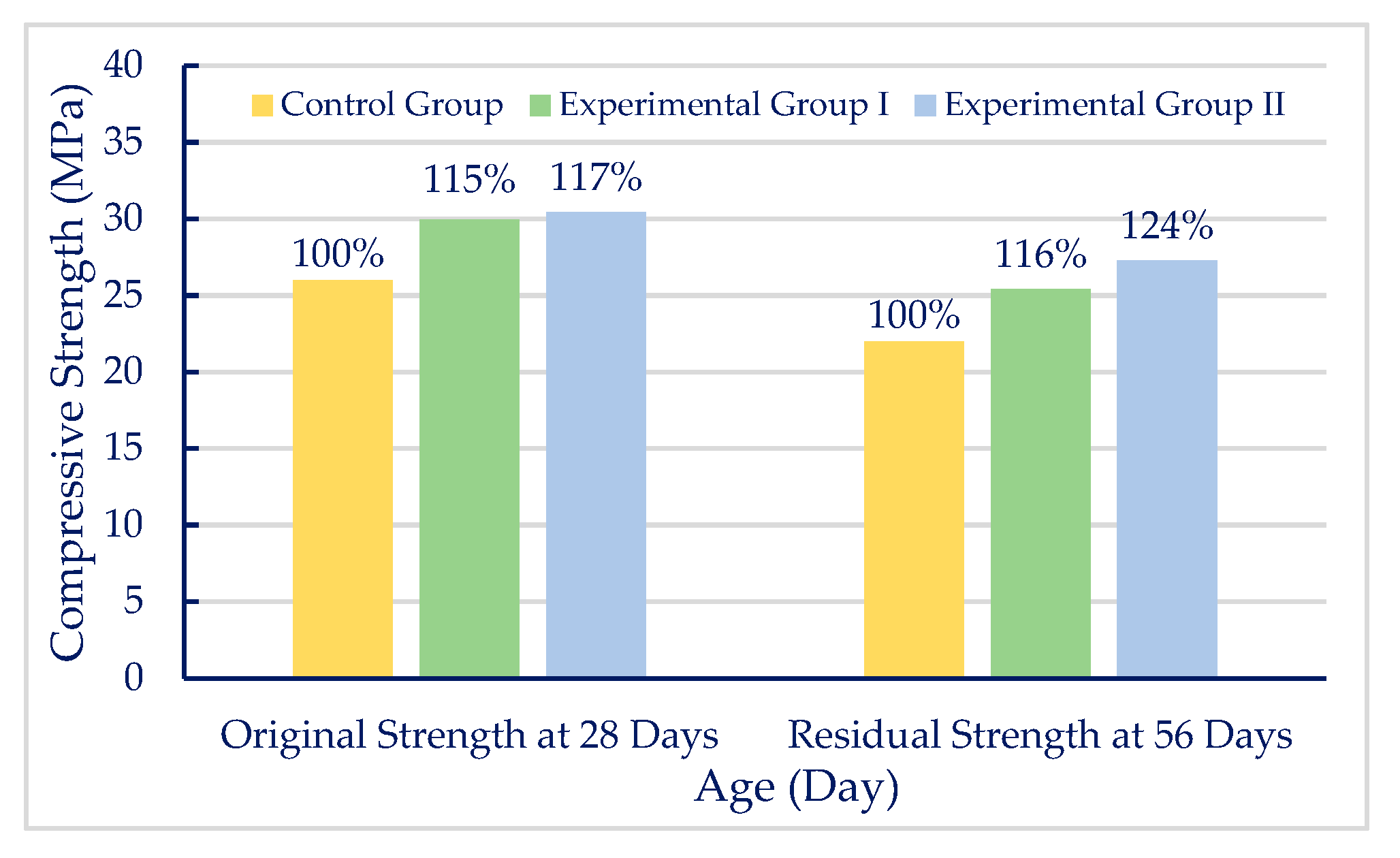
| Particle Density (g/cm3) | Water Absorption (%) | Loose Unit Weight (kg/m3) | Crushing Strength (MPa) | Porosity (%) | |
|---|---|---|---|---|---|
| 1-h | 24-h | ||||
| 0.99 | 5.28 | 7.35 | 477.86 | >3 | 24.97 |
| Mix No. | W/C | Water (kg/m3) | Cement (kg/m3) | Lightweight Aggregate (kg/m3) | Sand (kg/m3) |
|---|---|---|---|---|---|
| LC | 0.60 | 240 | 400 | 399 | 524 |
| Group | Compressive Strength (MPa) | |||||||
|---|---|---|---|---|---|---|---|---|
| 7 Days | 28 Days | 56 Days | 91 Days | |||||
| Individual Value | Average Value | Individual Value | Average Value | Individual Value | Average Value | Individual Value | Average Value | |
| Control Group | 18.89 | 19.04 | 26.43 | 26.89 | 31.76 | 31.10 | 31.42 | 31.20 |
| 19.09 | 26.75 | 30.53 | 31.19 | |||||
| 19.14 | 27.49 | 31.01 | 31.03 | |||||
| Experimental Group I | 25.34 | 25.28 | 29.64 | 29.15 | 33.63 | 33.18 | 33.76 | 33.92 |
| 25.69 | 29.50 | 32.40 | 34.12 | |||||
| 24.87 | 28.31 | 33.52 | 33.89 | |||||
| Group | Point 1 (mm) | Point 2 (mm) | Point 3 (mm) | Point 4 (mm) | Point 5 (mm) | Average Permeation Depth (mm) | Permeable Section Width (mm) | Total Permeation Area (mm2) |
|---|---|---|---|---|---|---|---|---|
| Control Group | 30 | 36 | 38 | 35 | 30 | 34 | 142 | 4828 |
| Experimental Group I | 16 | 23 | 25 | 20 | 15 | 20 | 82 | 1640 |
| Experimental Group II | 8 | 8 | 8 | 16 | 25 | 13 | 150 | 1950 |
| Group | Original Strength at 28 Days (MPa) | Residual Strength at 56 Days (MPa) | ||
|---|---|---|---|---|
| Individual Value | Average Value | Individual Value | Average Value | |
| Control Group | 26.19 | 26.00 | 21.09 | 21.97 |
| 25.51 | 19.72 | |||
| 26.29 | 25.11 | |||
| Experimental Group I | 29.92 | 29.96 | 25.51 | 25.41 |
| 29.82 | 25.31 | |||
| 30.15 | 25.40 | |||
| Experimental Group II | 31.10 | 30.46 | 27.32 | 27.30 |
| 31.18 | 27.81 | |||
| 29.74 | 26.78 | |||
| Group | Electric Flux (Coulombs) | |
|---|---|---|
| Individual Value | Average Value | |
| Control Group | 18,867 | 19,043 |
| 18,717 | ||
| 19,546 | ||
| Experimental Group I | 18,259 | 17,312 |
| 17,017 | ||
| 16,660 | ||
| Experimental Group II | 17,320 | 17,157 |
| 17,645 | ||
| 16,505 | ||
© 2020 by the authors. Licensee MDPI, Basel, Switzerland. This article is an open access article distributed under the terms and conditions of the Creative Commons Attribution (CC BY) license (http://creativecommons.org/licenses/by/4.0/).
Share and Cite
Chen, H.-J.; Chen, M.-C.; Tang, C.-W. Research on Improving Concrete Durability by Biomineralization Technology. Sustainability 2020, 12, 1242. https://doi.org/10.3390/su12031242
Chen H-J, Chen M-C, Tang C-W. Research on Improving Concrete Durability by Biomineralization Technology. Sustainability. 2020; 12(3):1242. https://doi.org/10.3390/su12031242
Chicago/Turabian StyleChen, How-Ji, Ming-Cheng Chen, and Chao-Wei Tang. 2020. "Research on Improving Concrete Durability by Biomineralization Technology" Sustainability 12, no. 3: 1242. https://doi.org/10.3390/su12031242
APA StyleChen, H.-J., Chen, M.-C., & Tang, C.-W. (2020). Research on Improving Concrete Durability by Biomineralization Technology. Sustainability, 12(3), 1242. https://doi.org/10.3390/su12031242






